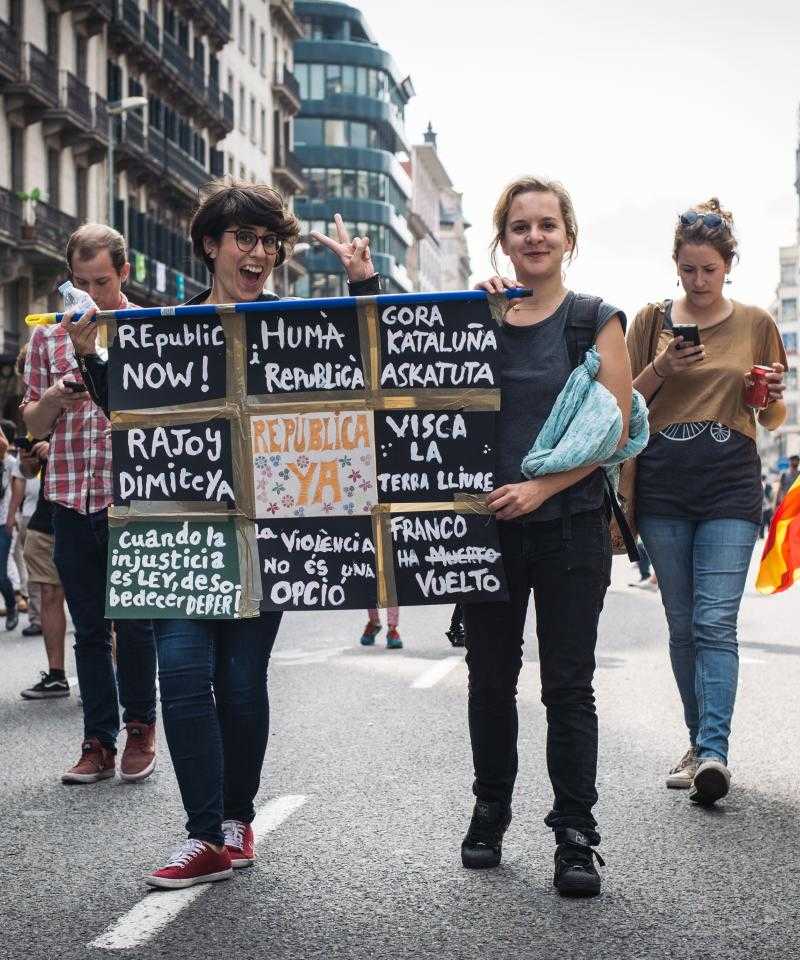1st October: A day for resistance

It seems that few could imagine that the problems made by the Spanish state for the Catalan referendum on 1st October would lead to exactly that which reinforces the legitimacy of the fight of many social claims: peaceful popular resistance.
And so, it does not matter if one is in favour or not of the demands for a large part of the population of Catalonia to make decisions related to the construction of their own separate state. What is certain is that the 1st October was a day for pacifists and antimilitarists to celebrate, as the Catalans chose to defend the referendum with nonviolent, peaceful resistance. Proving that antimilitarism continues to be alive and strong in Catalonia and becomes prevalent when a collective defence is needed to defend a shared political agenda.
The mission to carry out the referendum passed from the hands of the institutions and administrations to the cities and towns of Catalonia. This has led to something with greater social potential, self-organisation, solidarity and cooperation. The smell of coffee at five o’clock in the morning in the many schools that chose to resist represented the strength and potential of the collective group, a force generally suppressed by the state.
The resistance was loaded with historical symbolism. On 1st October 1936, the dictator Franco was named head of state by military force, implementing a fascist government with the support of the bourgeois and ecclesiastical elites. Eighty one years later, popular peaceful resistance, the seed of antimilitarism that was forged during Franco’s dictatorship, turns over history.
With respect to the complications faced to carry out the referendum, Catalonia responded in a way that gave homage to their history of peaceful actions such as the rejection of compulsory military conscription, Pepe Beunza and his trials of war and voting NO to remain in NATO in 1986 in the referendum held with the PSOE in government. More recent examples of this solidarity, based on pacifism and antimilitarism, can be seen in the protests against the Iraq war in 2003, the latest movements to take in refugees and the objection to the arms trade in the wake of the attack in Barcelona in August of this year.
Peaceful resistance is more than simply a tool utilised by the people to defend themselves against the violence that is often legitimised by the state. It is a political decision of resistance by the collective population with the basic purpose of social transformation. It is the declaration that if they are to build a new state of Catalonia, as asked for in the referendum, it must have the basic, pacifist foundations of antimilitarism, with the importance placed on how Catalonia is positioned in front of the world with respect to such political violence.
We can also find evidence of those who defend the rights of those who defend. Som Defensores, for example, is a project of various entities to deploy observers to all the schools involved, to report any instances of human rights violations. The same can be seen with various groups of lawyers banding together to defend the peoples right to resist, a right so easy to diminish in the legal intricacies of the institutions.
The infinite obstacles caused by violence, both structural, such as blocking the referendum from all structures of the state, and physical, the use of police riot squads on the schools involved, may have imposed fear but also acted to charge the resistance. Such a resistance was not easy, with the tension caused by civil disobedience, the many hours without sleep and the bodies used to create a barrier between the ballot boxes and the blows. The images of the schools with broken windows and doors symbolises the potential destructiveness of violence, and from down below, the pacifist resistance, determine and overwhelming, brought a constructive force both emotionally and physically.
However, this type of resistance is nothing new and in fact has been forged in social movements for some time. The body, our fragile body, when used as a barrier between forceful imposition and moral determination, is our only means to create real change. It is a hard lesson which must be learnt, the importance of a collective, united force in peaceful resistance because such a resistance is based fundamentally on the determination of the group which bond together to resist. It would be impossible to defend a school against an individual without this community connection.
Aside from the political objectives, or the results, the first of October was not only a day for the resistance to violence but was an overwhelming victory for antimilitarism.
Add new comment